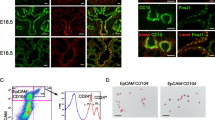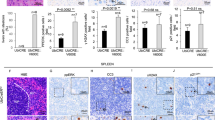Abstract
The human mutant p53(273H) has been shown in vitro to have both dominant-negative and gain-of-function properties, as well as to retain partial DNA-binding and transcriptional activation functions. We have developed a line of transgenic mice in which the human mutant p53(273H) is expressed in a lung specific manner (p53 +/+/TG). Crossing of the transgenic mice with p53 knockout mice led to generate mice with various genetic backgrounds. To evaluate the influence of p53 mutants in cell proliferation in mice lung tissue, we analyzed cell proliferation rate by Bromodeoxyuridine (BrdU) labeling and by expression of proliferating cell nuclear antigen (PCNA). BrdU analysis showed a 3.7-fold increase in the number of BrdU positive cells in the (p53 −/+/TG) mice compared to the (p53 −/+) mice, whereas no difference was observed in proliferation rate in the p53 −/−/TG lungs as compared to p53 −/− lungs. After the mice were treated with γ-irradiation, BrdU positive cells were absent from both the p53 −/+/TG and p53 −/+ mice, whereas a decrease in the rate of cell proliferation occurred in p53 −/−/TG lungs as compared to p53 −/− lungs. Real time PCR results indicated that the p53(273H) mutant did not retain the function to activate expression of p21 WAF1/CIP1 in the transgenic mice. The above results indicate that overexpression of the human mutant p53(273H) in vivo results in an increase in basal proliferation rate which requires the presence of wild type p53. Mutant p53(273H) may affect cell proliferation by interrupting murine endogenous p53 function.






Similar content being viewed by others
References
Alberg AJ, Brock MV, Samet JM (2005) Epidemiology of lung cancer: looking to the future. J Clin Oncol 23:3175–3185
Albor A, Kaku S, Kulesz-Martin M (1998) Wild-type and mutant forms of p53 activate human topoisomerase I: a possible mechanism for gain of function in mutants. Cancer Res 58:2091–2094
Bargonetti J, Reynisdottir I, Friedman PN, Prives C (1992) Site-specific binding of wild-type p53 to cellular DNA is inhibited by SV40 T antigen and mutant p53. Genes Dev 6:1886–1898
Blandino G, Levine AJ, Oren M (1999) Mutant p53 gain of function: differential effects of different p53 mutants on resistance of cultured cells to chemotherapy. Oncogene 18:477–485
Brugarolas J, Chandrasekaran C, Gordon JL, Beach D, Jacks T, Hannon GJ (1995) Radiation-induced cell cycle arrest compromised by p21 deficiency. Nature 377:552–557
Burns TF, Bernhard EJ, El-Deiry WS (2001) Tissue specific expression of p53 target genes suggests a key role for KILLER/DR5 in p53-dependent apoptosis in vivo. Oncogene 20:4601–4612
Cayrol C, Knibiehler M, Ducommun B (1998) p21 binding to PCNA causes G1 and G2 cell cycle arrest in p53-deficient cells. Oncogene 16:311–320
Cho Y, Gorina S, Jeffrey PD, Pavletich NP (1994) Crystal structure of a p53 tumor suppressor-DNA complex: understanding tumorigenic mutations. Science 265:346–355
D’Amico D, Carbone D, Mitsudomi T, Nau M, Fedorko J, Russell E, Johnson B, Buchhagen D, Bodner S, Phelps R, Gazdar A, Minna JD (1992) High frequency of somatically acquired p53 mutations in small-cell lung cancer cell lines and tumors. Oncogene 7:339–346
Dittmer D, Pati S, Zambetti G, Chu S, Teresky AK, Moore M, Finlay C, Levine AJ (1993) Gain of function mutations in p53. Nat Genet 4:42–46
Donehower LA, Harvey M, Slagle BL, McArthur MJ, Montgomery CA Jr, Butel JS, Bradley A (1992) Mice deficient for p53 are developmentally normal but susceptible to spontaneous tumours. Nature 356:215–221
Duan W, Ding H, Subler MA, Zhu WG, Zhang H, Stoner GD, Windle JJ, Otterson GA, Villalona-Calero MA (2002a) Lung-specific expression of human mutant p53-273H is associated with a high frequency of lung adenocarcinoma in transgenic mice. Oncogene 21:7831–7838
Duan W, Ding H, Zhu WG, Srinivasan K, Ottersom GA, Villalona-Calero MA (2002b) RT-PCR heteroduplex analysis permits differentiation of transgene and host gene expression in a transgenic animal model. Biotechniques 33:58–66
El-Deiry WS, Tokino T, Velculescu VE, Levy DB, Parsons R, Trent JM, Lin D, Mercer WE, Kinzler KW, Vogelstein B (1993) WAF1, a potential mediator of p53 tumor suppression. Cell 75:817–825
El-Hizawi S, Lagowski JP, Kulesz-Martin M, Albor A (2002) Induction of gene amplification as a gain-of-function phenotype of mutant p53 proteins. Cancer Res 62:3264–3270
Engel FB, Hauck L, Boehm M, Nabel EG, Dietz R, von Harsdorf R (2003) p21(CIP1) Controls proliferating cell nuclear antigen level in adult cardiomyocytes. Mol Cell Biol 23:555–565
Glasser SW, Burhans MS, Eszterhas SK, Bruno MD, Korfhagen TR (2000) Human SP-C gene sequences that confer lung epithelium-specific expression in transgenic mice. Am J Physiol Lung Cell Mol Physiol 278:L933–L945
Harper JW, Adami GR, Wei N, Keyomarsi K, Elledge SJ (1993) The p21 Cdk-interacting protein Cip1 is a potent inhibitor of G1 cyclin-dependent kinases. Cell 75:805–816
Kawamura M, Yamashita T, Segawa K, Kaneuchi M, Shindoh M, Fujinaga K (1996) The 273rd codon mutants of p53 show growth modulation activities not correlated with p53-specific transactivation activity. Oncogene 12:2361–2367
Kern SE, Pietelpol JA, Thiagalingam S, Seymour A, Kinzler KW, Vogelstein B (1992) Oncogenic forms of p53 inhibit p53-regulated gene expression. Science 256:827–830
Ko JL, Prives C (1996) p53: puzzle and paradigm. Genes Dev 10:1054–1072
Korfhagen TR, Glasser SW, Wert SE, Bruno MD, Daugherty CC, McNeish JD, Stock JL, Potter SS, Whitsett JA (1990) Cis-acting sequences from a human surfactant protein gene confer pulmonary-specific gene expression in transgenic mice. Proc Natl Acad Sci USA 87:6122–6126
Martin-Caballero J, Flores JM, Garcia-Palencia P, Serrano M (2001) Tumor susceptibility of p21(Waf1/Cip1)-deficient mice. Cancer Res 61:6234–6238
Milner J, Medcalf EA, Cook AC (1991) Tumor suppressor p53: analysis of wild-type and mutant p53 complexes. Mol Cell Biol 11:12–19
Mitsudomi T, Steinberg SM, Nau MM, Carbone D, D’Amico D, Bodner S, Oie HK, Linnoila RI, Mulshine JL, Minna JD (1992) p53 gene mutations in non-small-cell lung cancer cell lines and their correlation with the presence of ras mutations and clinical features. Oncogene 7:171–180
Olive KP, Tuveson DA, Ruhe ZC, Yin B, Willis NA, Bronson RT, Crowley D, Jacks T (2004) Mutant p53 gain of function in two mouse models of Li-Fraumeni syndrome. Cell 119:847–860
Olivier M, Eeles R, Hollstein M, Khan MA, Harris CC, Hainaut P (2002) The IARC TP53 Database: new online mutation analysis and recommendations to users. Hum Mutat 19:607–614
Park DJ, Nakamura H, Chumakov AM, Said JW, Miller CW, Chen DL, Koeffler HP (1994) Transactivational and DNA binding abilities of endogenous p53 in p53 mutant cell lines. Oncogene 9:1899–1906
Paunesku T, Mittal S, Protic M, Oryhon J, Korolev SV, Joachimiak A, Woloschak GE (2001) Proliferating cell nuclear antigen (PCNA): ringmaster of the genome. Int J Radiat Biol 77:1007–1021
Sigal A, Rotter V (2000) Oncogenic mutations of the p53 tumor suppressor: the demons of the guardian of the genome. Cancer Res 60:6788–6793
Vairapandi M, Azam N, Balliet AG, Hoffman B, Liebermann DA (2000) Characterization of MyD118, Gadd45, and proliferating cell nuclear antigen (PCNA) interacting domains. PCNA impedes MyD118 AND Gadd45-mediated negative growth control. J Biol Chem 275:16810–16819
van Oijen MG, Slootweg PJ (2000) Gain-of-function mutations in the tumor suppressor gene p53. Clin Cancer Res 6:2138–2145
Wu L, Bayle JH, Elenbaas B, Pavletich NP, Levine AJ (1995) Alternatively spliced forms in the carboxy-terminal domain of the p53 protein regulate its ability to promote annealing of complementary single strands of nucleic acids. Mol Cell Biol 15:497–504
Xiong Y, Hannon GJ, Zhang H, Casso D, Kobayashi R, Beach D (1993) p21 is a universal inhibitor of cyclin kinases. Nature 366:701–704
Xu J, Morris GF (1999) p53-mediated regulation of proliferating cell nuclear antigen expression in cells exposed to ionizing radiation. Mol Cell Biol 19:12–20
Zhang W, Funk WD, Wright WE, Shay JW, Deisseroth AB (1993) Novel DNA binding of p53 mutants and their role in transcriptional activation. Oncogene 8:2555–2559
Acknowledgements
We thank Dr. Mark A. Subler, Dr. Jolene J. Windle, Dr. Haiming Ding and Dr. Wei-Guo Zhu for their work in establishment of the SP-C/p53(273H) transgenic mice. We thank the Transgenic Core Facility, Histology Core Facility and Real Time PCR Shared Resource at OSU for their assistance.
Author information
Authors and Affiliations
Corresponding author
Additional information
David Jin was a senior from the Worthington Kilbourne High School, Ohio.
Rights and permissions
About this article
Cite this article
Duan, W., Gao, L., Jin, D. et al. Lung specific expression of a human mutant p53 affects cell proliferation in transgenic mice. Transgenic Res 17, 355–366 (2008). https://doi.org/10.1007/s11248-007-9154-3
Received:
Accepted:
Published:
Issue Date:
DOI: https://doi.org/10.1007/s11248-007-9154-3




